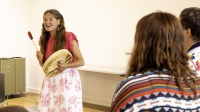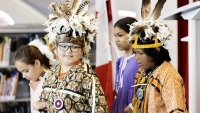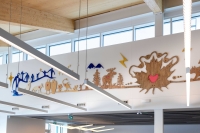Southwest Library: Built on Indigenous Consultation
Kitchener Public Library
Innovation Synopsis
Southwest Library is the first civic building in Kitchener created through formal consultation with Indigenous Rights Holders. From its earliest planning stages, the Six Nations of the Grand River and the Mississaugas of the Credit guided how the library would reflect Indigenous values in its architecture, public art, and community spaces. The result is a Net Zero library that integrates a Four Directions learning garden, circular gathering areas, and Indigenous storytelling artwork. This process transformed consultation from tokenism to partnership—embedding reconciliation in design, governance, and operations—while advancing environmental sustainability, and equitable access for a rapidly growing, diverse community.
Challenge/Opportunity
Historical exclusion: Public infrastructure projects have often excluded or tokenized Indigenous voices including those of land rights holders.
Community need: Southwest Kitchener is the fastest-growing area of the city, with limited civic and cultural amenities; more than 40% of residents are newcomers to Canada.
Cultural responsibility: Indigenous artifacts and a Late Iroquoian longhouse village were discovered near the site, emphasizing shared responsibility for land and heritage.
Consultation gap: Indigenous partners called for authentic, rights-based collaboration rather than symbolic engagement.
Opportunity:
-Build Truth and Reconciliation – acknowledging the legacy of the residential school system on Indigenous peoples and working towards a mutually respectful relationship between Indigenous and non-Indigenous peoples in Canada – into process and outcome
-Align climate action and cultural equity through Net Zero design
-Create welcoming, barrier-free spaces for ceremony
Key Elements of Innovation
Formal Rights Holder Consultation: Six Nations of the Grand River and Mississaugas of the Credit engaged as decision-makers throughout design and implementation.
Design Integration: Four Directions learning garden, indigenous landscaping, ceremonial gathering areas, children's area design feature, and Indigenous-led public art (“Wintertime Stories”) co-created through civic and Indigenous partnerships
Equity and Inclusion: Fully accessible, gender-neutral washrooms, smudge-friendly rooms; spaces for gathering, cooking and creation, and community-led programming.
Partnership Model: Collaboration among KPL, City of Kitchener, architects, Federal Government, SpruceLab landscape design, Indigenous artists, and accessibility consultants.
Sector Innovation: First library in Waterloo Region to embed reconciliation within governance and infrastructure, linking environmental sustainability and cultural equity.
Achieved Outcomes
Cultural Impact: Indigenous art, gardens and other architectural elements visibly honour local histories; local Elders, artists, and dancers participated in opening celebrations.
Partnership Outcomes: Consultation model designated and adopted for future civic projects; new relationships built with Indigenous architects and cultural advisors.
Community Feedback: During a community presentation, a representative from the Six Nations Lands and Resources Department affirmed that KPL had met—and exceeded—their expectations for community consultation and implementation.
Indigenous Program Participation: Indigenous Sharing Circles (27), Cooking with Chef Destiny (20), Grand Opening (115), Missing and Murdered Indigenous Women, Girls and Two-Spirited installation and memorial (30), Sing Fires of Justice (55).
Sustainability Metrics: Net-zero certification achieved
Legacy: Program room named Ka'nikonhrí:io Nikanak’tó:ten— “the good minds meeting space”—a gift from Six Nations.



